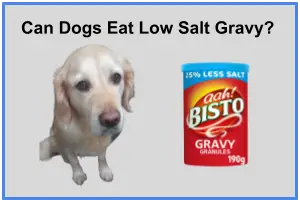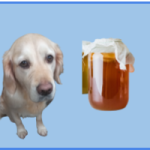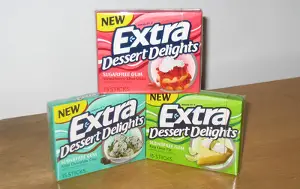
We all know our pet pooch loves nothing more than licking leftover gravy from the inside of a dishwasher.
Or, even better, in their dog bowl with some kibble or meat!
They find it incredibly addictive and they’d eat it all day if they could.
Can dogs actually eat gravy, though? And is it much better if there’s reduced salt?
Let’s have a look at both the short-term and long-term consequences of the low salt option for one of the world’s most popular sauces.
What is low salt gravy?
Low salt gravy generally contains between 25-30% less sodium than regular gravy.
Unlike sugar-free products where xylitol can be used instead, there cannot be completely salt-free gravy due to there being no ready-made replacement for the salt.
The products use flavour enhancers to make up for the reduced salt.
Bisto, the most popular gravy brand on the market, has a ‘25% Less Salt’ option with 0.28 grams per 100ml.
Regular Bisto Gravy contains 0.94 grams per 100ml, which is 16% of the recommended intake.
McCormick’s regular Brown Gravy contains 0.34 grams per 100ml, with the ‘30% Less Sodium’ option containing 0.23 grams per 100ml.
What are the other main ingredients in low salt gravy?
Great, it’s good that there’s reduced salt. What about the rest of the ingredients though? Are there any I really need to know about?
Bisto’s ‘25% Less Salt’ has the following main ingredients: Potato Starch, Palm Fat, Salt, Wheat Flour, Flavour Enhancers (including MSG), Sugar and Onion Oil.
McCormick’s ‘30% Less Sodium’ contains the following main ingredients: Enriched Wheat Flour, Wheat Starch, Rendered Beef Fat, Hydrolyzed Soy Protein, Gluten, Salt, Onion, Flavor Enhancers, Sodium Caseinate (Milk), Sugar and Garlic.
Both ‘low salt’ options contain the same ingredients as the regular gravy, however, with the addition of flavour enhancers.
Both gravies contain MSG (Monosodium Glutamate). The long-term effects of MSG are not yet known but studies have shown the effects on animals to be varied, including stunting, obesity and dead tissue in the brain.
Why might low salt gravy be unhealthy for dogs?
You may be wondering, why bring out a reduced salt version if it’s still going to be unhealthy?
Firstly, it’s important to mention that any salt levels for a dog are unhealthy and can cause long-term medical issues. For example, dogs can develop sodium poisoning from consuming too much salt.
Both low salt gravies above contain garlic and onion, which are extremely harmful to dogs. Both contain n-propyl disulphide, which is toxic to certain animals. The compound causes a breakdown in red blood cells, leading to anaemia, even in perfectly healthy dogs.
Wheat and gluten can be harmful to dogs who have an intolerance.
Also, the presence of MSG is a warning sign. There are no positive benefits to MSG, only harmful.
Why might low salt gravy benefit dogs?
Surely there are some benefits to low salt gravy? The gravy does contain some benefits for dogs which can actually help with their long-term health.
Some of the ingredients can provide tiny benefits. For example, sodium caseinate is a quality protein well tolerated by dogs.
However, despite the fact some ingredients can offer small benefits, it’s not the best nutritional choice for a dog. Rather, just enjoy how much they adore licking gravy from your dishwasher or smothering it all over their dry dog food!
What is the nutrition in low salt gravy?
Have you ever wondered how fatty gravy actually is? Surely something that tastes so good must have secret hidden fat content?
Well, notably, low salt gravies do still have 70-75% of the salt levels found in regular gravy. Both have very low levels of fat, just 0.5 grams. Depending on the size of the dog, they can have between 14 grams (for a small dog) and 28 grams (for a large dog). Puppies may even need more!
Bisto Reduced Salt contains 14 calories per 100ml, with McCormick’s Less Sodium containing 20. It can vary, but dogs typically require 200-400 calories per day. This really depends on the size of the dog, plus the amount of daily exercise they have.
A portion size, then, would be around 5-10% of a dog’s daily allowance, just for gravy.
Can dogs eat Bisto gravy?
So, my dog’s favourite day of the week is Sunday. His favourite thing is licking my plate clean of gravy once it’s finished.
If it’s bad for dogs though, how come he’s never gotten poorly?
It’s best for dogs to avoid Bisto gravy, due to the potential health risks.
Whilst your dog may already enjoy gravy on your Sunday roast dinner leftovers, just be aware that it can only be allowed in small doses.
What happens if my dog decides to eat the entire jug?
As long as your dog avoids overeating, they will likely not be vulnerable to sodium poisoning. However, salt and fat will provide long-term health consequences, such as obesity or acute pancreatitis.
The presence of onion powder and E-numbers can also be toxic to dogs.
Are there really no positives whatsoever?
Bisto can provide some healthy nutrients for your dog. Potato starch has the benefit of aiding digestion, while inactive yeast powder can be a useful protein and vitamin B source. However, due to the risk of other ingredients, it’s best to source these nutrients elsewhere.
The great news is you can make your own dog gravy, which will be twice as tasty – in part because they can have as much as they like!
Can dogs eat homemade gravy?
Sometimes you don’t always go for instant gravy. You may be wondering whether your dog can enjoy your homemade gravy?
They can, but only dog gravy or a homemade gravy with no salt, garlic, onion or additives.
The obvious benefit of homemade dog gravy or dog gravy products is that they’re perfectly tailored for pooches’ diets, as well as carefully avoiding their sensitivities and allergies. They’re made from minimally processed whole foods with a distinct lack of obscure ingredients.
How do you make homemade gravy?
Homemade dog gravy can be made with natural products such as chicken, carrots, butternut squash, thyme and sage. This makes it tasty without adding flavourings or salt.
There are plenty of specially designed dog gravy recipes or products specifically targeted at dog health. Noticeable is the presence of ingredients such as dried spinach and flaxseed in the place of E-numbers, artificial flavours, colours, or preservatives.
Okay. I can’t imagine there’s a gravy alternative? In case I want to mix it up a little?
Actually, a gravy alternative can be a fantastic opportunity to add real nutritional value to your dog’s food intake. Bone broth is increasingly being added to dog gravy or kibble toppers. It’s a brilliant source of protein, collagen, glycine and glucosamine. This can really help with bone health and muscle growth.
Kibble toppers and dog gravy also contain taurine, which helps with heart function, as well as brain and eye health.
Ingredients such as beef and carrots are also far better sources of protein than inactive yeast powder.
Anything else I need to know?
Dog gravy also contains absolutely no MSG, onion, salt, gravy or E-numbers.
Low salt gravy vs dog gravy
I know what you’re thinking. Dog gravy may be hard to come by, or you may not have time to make it.
Is there a difference between low salt gravy and dog gravy?
Dog gravy still has the overwhelming benefit of being specially tailored for dogs’ diets. They contain a multitude of natural positive food sources for dogs, such as taurine and protein. The variety in the ingredients is also hugely beneficial.
The ingredients of low salt gravy offer a lot of redundant nutritional benefits. There is still also enough salt to cause potential harm to the dog, as well as onion and garlic.
Is there a big difference?
The huge difference between these too is that gravy also contains saturated fats and unhealthy carbohydrates, which can cause an upset stomach. Long-term, this can affect a dog’s heart health.
Dog gravy is not just harmless, it’s a very good addition to a dog’s diet.
Other ways of making kibble appetising
We know it can be hard to wean dogs off eating gravy. Sometimes (when allowed!) they love wolfing down kibble drowning in gravy.
But are there any other alternatives?
Gravy can be used to enhance the flavour of kibble, but thankfully there are much healthier options available.
What else is there?
There are dog gravies and kibble toppers on the market specially designed to promote dog health. One such popular favourite flavour is bone broth.
Not only can you improve the flavour of the kibble, but you can also use this as an opportunity to get secret vitamins or nutrients into your dog’s body without them knowing!
How much shall I feed my dog?
It’s suggested to apply the ‘50% rule’ here’, trying to replace 50% of your dog’s kibble with fresh, whole foods. As you try to move your dog away from carbohydrates and fats, replace the gravy with as much fresh food as possible.
Digestive enzymes are a good choice to sprinkle on a dog’s food. These are supplements which contain live probiotics and promote both good health and digestibility.
You can also purchase meal toppers in the form of steamed vegetables, which can be grated or blended so your dog doesn’t notice.
Closing thoughts – can dogs eat low salt gravy?
So, the big question is: can dogs eat low salt gravy?
Despite the presence of less salt, it’s best for dogs to avoid even low salt gravy, due to the potential health risks involved.
Whilst your dog can enjoy licking gravy from the dishwasher, just make sure they’re supervised.
As long as your dog avoids overeating, they will likely not be vulnerable to sodium poisoning. However, salt and fat will provide short and long-term health consequences, such as toxicity, obesity or acute pancreatitis.
Both gravies contain MSG (Monosodium Glutamate), which can have severe health consequences.
The presence of onion powder and E-numbers can also be toxic to dogs.
Low salt gravy can provide some healthy nutrients for your dog. Potato starch has the benefit of aiding digestion, whilst inactive yeast powder can be a useful protein and vitamin B source. Sodium caseinate is also a quality protein source for dogs. However, due to the risk of other ingredients, it’s best to source these nutrients elsewhere.
The great news is you can make or purchase dog gravy, which can be tailored specifically for your dog’s health requirements or preferences.






